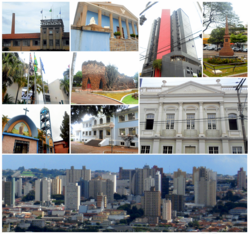Limeira, Brazil
| Limeira | |||
|---|---|---|---|
| Municipality | |||

From the left to the right: the Prada Building, the Fraternity Palace, Commercial Centre Edifice, revolutionary monument on Toledo Barros plaza, the Spencer Vampré City Forum, the Grotto, the Levy Manour, St. Thérèse of Lisieux Church, E.E. Brasil high school and skyline seen from Jd. Planalto.
|
|||
|
|||
 Location in São Paulo state |
|||
| Location in Brazil | |||
| Coordinates: 22°33′53″S 47°24′6″W / 22.56472°S 47.40167°WCoordinates: 22°33′53″S 47°24′6″W / 22.56472°S 47.40167°W | |||
| Country |
|
||
| Region | Southeast Region | ||
| State | São Paulo | ||
| Government | |||
| • Mayor | Paulo Hadich | ||
| Area | |||
| • Total | 581 km2 (224 sq mi) | ||
| Elevation | 588 m (1,929 ft) | ||
| Population (2015) | |||
| • Total | 296,440 | ||
| • Density | 510/km2 (1,300/sq mi) | ||
| Time zone | BRT/BRST (UTC-3/-2) | ||
| Website | www |
||
Limeira is a city in the eastern part of the Brazilian state of São Paulo. The population is 296,440 (2015 est.) in an area of 581 km². The elevation is 588 m. It is 154 km from São Paulo, the state capital, and 1011 km from Brasilia, Brazil's capital. The city can be easily reached from São Paulo by two highways: Rodovia Anhanguera and Rodovia dos Bandeirantes.
Once an important and strategical pole of the coffee culture, Limeira was also known as the "Brazilian orange capital" due to the great citrus production that occurred in the past, although now the main crop cultivated in the city is the sugar cane. Afterwards, it became recognized by its new plated jewelry and semi-jewelry industry which attract customers from all over the world, giving the city the title of "Brazil's plated jewelry capital". There are more than 450 companies that are responsible for half of Brazil's exports in this sector.
There is a famous farm located in Limeira, Fazenda Ibicaba, that belonged to Nicolau de Campos Vergueiro, who brought the first immigrants from Europe, especially from Germany, Portugal, Switzerland and Belgium, to replace the enslaved African-Brazilian workers, which was basically a government effort to "bleach" the race, as it was feared Brazil would become a "black country". Limeira is thus said to have accomplished the first positive experience with immigrant workers in Brazil. Probably because Northern Europeans preferred to run their own farms rather than to subject themselves to indentured work and the Portuguese tended to work in commerce, Italian immigrants were brought to work the fields. Such immigrant groups were greater in numbers than all the others all over São Paulo state. Northern Europeans and the first Italians to arrive in the country often came with the promise of being granted lands in exchange for their work, but the last ones were treated socially only better than the slaves themselves. The latter, nonetheless, had nowhere to go for jobs as slavery ended and many begged to be rehired for food. The situation of some of them improved when the British installed the railway in the country and gave them prestigious jobs with housing. Today, Limeira is located in a prosperous region in São Paulo State.
...
Wikipedia



